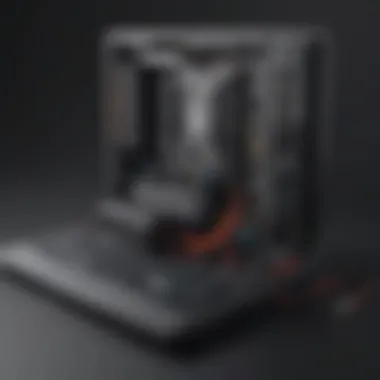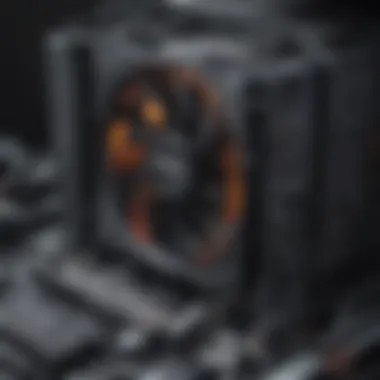Mastering PC Efficiency: A Guide to Optimal Clean-Up


Software Overview
To embark on the journey of optimizing your PC, understanding the software landscape is paramount. This section introduces the tools essential for decluttering and reviving your computer's performance. Delve into the key features and functionalities that these software solutions offer. Affordable pricing plans and varied subscription options cater to diverse user needs.
User Experience
Navigating through the software interface shapes the user experience. Discover the intricacies of user interface design and the elements that facilitate efficient PC clean-up. Evaluate the software's ease of use, examining the learning curve required to master the tools. Customer support options play a pivotal role, ensuring reliability for users seeking assistance.
Performance and Reliability
Unveil the performance metrics that define the efficacy of PC optimization software. Speed and efficiency indicators reflect how swiftly tasks are executed. Uptime and downtime statistics reveal the software's reliability, vital for uninterrupted usage. Explore the integration capabilities with other tools, enhancing the software's utility in diverse tech ecosystems.
Security and Compliance
In the digital realm, security is paramount. Delve into the data encryption measures embedded within PC optimization software. Assess the software's compliance with industry regulations, safeguarding user data and operations. Backup and disaster recovery protocols are critical aspects ensuring data integrity and continuity in case of unforeseen events.
Understanding the Importance of PC Clean Up
In the realm of digital optimization, the significance of PC clean-up cannot be overstated. A fundamental pillar in ensuring seamless functionality and peak performance, PC clean-up is the cornerstone of efficient computing practices. By delving into the depths of your system and decluttering redundancies, you pave the way for enhanced productivity and operational fluidity. This section embarks on a journey to unravel the intricacies of maintaining a pristine digital environment to elevate your PC usage experience to unparalleled heights.
Defining PC Clean Up
Identifying Unnecessary Files
Embarking on the adventure of identifying unnecessary files is akin to traversing a labyrinth of digital detritus. By singling out superfluous documents, images, or applications, you streamline your PC's functionality and declutter its virtual corridors. The prowess of identifying unnecessary files lies in its ability to optimize storage space and amplify system responsiveness. However, one must tread cautiously, as misidentifying vital files could lead to unforeseen repercussions, underscoring the delicate balance of this digital pursuit.
Clearing Cache and Temporary Files
Diving into the realm of cache and temporary files clearance is a strategic maneuver to eliminate digital debris that accumulates over time. This process liberates valuable system resources and expedites data retrieval, contributing to a swifter and more streamlined computing experience. The crux of clearing cache and temporary files is to untangle the web of residual data strands that may impede your system's efficiency, heralding a new era of digital swiftness and responsiveness.
Organizing Data and Folders
Embracing the art of data and folder organization is akin to sculpting a masterpiece from chaos. By categorizing and labeling data with meticulous precision, you sow the seeds of structured efficiency within your PC ecosystem. The essence of organizing data and folders lies in its transformative power to enhance accessibility and workflow fluidity. Nevertheless, one must exercise caution to avoid over-categorization, which could potentially backfire and impede rather than optimize your digital landscape.
Benefits of Regular PC Clean Up
Improved Performance


The proposition of improved performance serves as a beacon of promise in the realm of PC optimization. By fine-tuning system configurations and eliminating digital ballast, you unlock newfound speed and agility in your computing endeavors. The allure of improved performance lies in its ability to catapult your PC's functionality to pristine levels, enabling seamless multitasking and swift application launches. However, the pursuit of enhanced performance necessitates a nuanced approach, as over-optimization could lead to unintended consequences, underscoring the delicate equilibrium in this digital endeavor.
Enhanced Security
Venturing into the domain of enhanced security is a paramount consideration in the landscape of PC maintenance. By fortifying your system against digital threats and vulnerabilities, you shield your sensitive data and personal information from malicious intent. The core tenet of enhanced security lies in its proactiveness against evolving cyber threats, establishing a formidable digital defense mechanism. However, one must remain vigilant in adopting security protocols, as complacency could expose a chink in your digital armor, inviting potential breaches and intrusions.
Extended Hardware Lifespan
Exploring the realm of extended hardware lifespan unveils a realm of longevity and sustainability in your PC infrastructure. By implementing robust clean-up practices, you mitigate the wear and tear on physical components, prolonging their operational viability. The crux of extended hardware lifespan lies in its cost-effective nature, sparing you from premature hardware replacements and exorbitant repair costs. Nevertheless, it is imperative to strike a balance in maintenance routines, as overzealous interventions could inadvertently strain hardware components, undermining the very goal of longevity and resilience in your digital arsenal.
Essential Tools and Software for PC Clean Up
Disk Cleanup Utilities
CCleaner
CCleaner, a prominent disk cleanup utility, is renowned for its ability to efficiently remove temporary files, cookies, and other unnecessary clutter that accumulate over time on a computer system. Its key characteristic lies in its user-friendly interface and powerful cleaning capabilities. CCleaner stands out as a popular choice for this article due to its versatile features, including registry cleaning, software uninstallation, and startup program management. While its unique feature of customizability provides users with control over the cleaning process, some may find its extensive range of options overwhelming.
BleachBit
Bleach Bit, another notable disk cleanup tool, contributes significantly to the overall goal of PC clean up by offering secure deletion of unnecessary files and maintaining user privacy. The key characteristic of BleachBit is its focus on protecting sensitive information while decluttering the system. This feature makes it a beneficial choice for users who prioritize data security. With its unique feature of file shredding for irrevocable deletion, BleachBit ensures that deleted files cannot be recovered. However, its disadvantage lies in a potentially less intuitive interface compared to other tools.
Disk Cleanup (Windows)
Disk Cleanup, an inbuilt utility in Windows operating systems, serves as a convenient tool for removing temporary files, system logs, and other unused data. Its key characteristic of being native to Windows makes it a popular choice for users seeking a straightforward solution. Disk Cleanup's unique feature of seamless integration with the operating system ensures ease of access and functionality. While it offers a simple and direct way to free up disk space, its disadvantage may include limitations in deep cleaning functionalities compared to third-party tools.
Manual Techniques for Effective PC Clean Up
In this section of the article on Optimizing Your PC, we delve into the manual techniques that play a crucial role in enhancing your computer's performance and longevity. By focusing on hands-on approaches to clean up your PC, you can achieve not only immediate improvements but also long-term benefits. Manual techniques involve proactive interventions that address specific issues and ensure your system runs efficiently. From deleting unnecessary programs to optimizing system settings and cleaning internal components, manual techniques cover a wide array of actions that are essential for maintaining a healthy PC.
Deleting Unused Programs
When it comes to optimizing your PC, one of the key manual techniques is deleting unused programs. This process involves removing software applications that are no longer needed or used, thereby freeing up valuable storage space and system resources. Uninstalling software, managing startup programs, and removing bloatware are fundamental steps in decluttering your PC and enhancing its performance.
Uninstalling Software
The act of uninstalling software is a critical aspect of decluttering your system. By removing unnecessary programs, you can streamline your PC's operation, reduce memory consumption, and eliminate potential conflicts between software applications. Uninstalling software allows you to reclaim disk space and ensure that only essential programs are running, leading to a more efficient computing experience.
Managing Startup Programs


Managing startup programs is another vital element in optimizing your PC. Controlling which programs launch at startup can significantly impact your system's boot time and overall performance. By disabling unnecessary startup applications, you can expedite the startup process, reduce system lag, and improve overall responsiveness. Effective management of startup programs can lead to a smoother user experience and optimized resource utilization.
Removing Bloatware
Removing bloatware, the pre-installed software that comes with many computers, is a crucial step in decluttering your PC. Bloatware not only takes up valuable disk space but can also slow down your system and compromise your privacy. By eliminating bloatware, you can enhance your PC's performance, security, and efficiency. Removing this unwanted software frees up resources and ensures that your system operates at its full potential, without unnecessary hindrances.
Optimizing System Settings
Optimizing system settings is a key component of effective PC clean up. By fine-tuning various system configurations, you can improve performance, enhance stability, and customize your computing environment to suit your preferences. Adjusting power settings, managing virtual memory, and updating drivers are essential aspects of optimizing system settings to ensure your PC runs smoothly and efficiently.
Adjusting Power Settings
One important aspect of optimizing system settings is adjusting power settings to balance performance and energy efficiency. By customizing power plans and settings, you can optimize how your PC consumes power, prolong battery life on laptops, and regulate system responsiveness. Adjusting power settings allows you to tailor your computer's energy usage to meet your needs and preferences, creating a more energy-efficient and personalized computing experience.
Managing Virtual Memory
Managing virtual memory plays a critical role in optimizing system performance and preventing memory-related issues. By adjusting virtual memory settings, you can alleviate RAM constraints, enhance system multitasking capabilities, and mitigate potential crashes or slowdowns. Effective management of virtual memory ensures that your system allocates resources efficiently, leading to improved responsiveness and overall stability.
Updating Drivers
Updating drivers is an essential task in maintaining system compatibility, performance, and security. By keeping device drivers up to date, you can resolve compatibility issues, improve hardware functionality, and address security vulnerabilities. Updating drivers ensures that your PC can communicate effectively with its components, peripherals, and external devices, maximizing performance and minimizing potential system errors. Regular driver updates are crucial for optimal system functioning and overall stability.
Advanced Tips for Deep PC Clean Up
When delving into the realm of deep PC clean up, one cannot overlook the significance of advanced tips. This section serves as a pivotal juncture in the guide to optimizing your PC, as it uncovers intricate methods that go beyond the surface-level clean up. By incorporating advanced tips, users can achieve a profound transformation in their system's performance and longevity. These techniques transcend basic maintenance, offering a meticulous approach to addressing underlying issues and enhancing the overall efficiency of the PC. Implementing advanced tips is not merely an option but a necessity for individuals seeking to maximize their computing experience to its fullest potential.
Registry Cleaning
Using Registry Cleaners
Diving into the specifics of using registry cleaners unveils a critical aspect of PC optimization. Registry cleaners play a crucial role in streamlining the Windows registry by eliminating redundant, obsolete, or corrupt entries. Their primary function is to enhance system performance by decluttering the registry database, ultimately leading to smoother operation and faster response times. One key characteristic of registry cleaners is their ability to scan and identify invalid entries, translating into a more organized and efficient registry structure. While using registry cleaners can significantly boost system performance, it is essential to exercise caution and select reputable software to avoid potential risks associated with registry edits.
Manual Registry Edits
Manual registry edits represent a hands-on approach to fine-tuning the Windows registry for optimal performance. This method involves directly modifying registry keys and values to rectify issues or customize system settings according to user preferences. One of the main advantages of manual registry editing is the level of control it offers, allowing users to tailor registry configurations to suit their specific needs. However, novice users should proceed with caution when performing manual edits, as incorrect changes can potentially disrupt system functionality and stability.
Backing Up Registry
Backing up the registry is a fundamental practice that mitigates the risks associated with registry modifications. A crucial aspect of PC maintenance, backing up the registry ensures that users can revert to a previous stable state in case of unintended consequences from registry changes. By creating restore points or full registry backups, individuals can safeguard against system errors or crashes resulting from erroneous edits. Prioritizing regular registry backups is imperative for preserving system integrity and mitigating the impact of any potential mishaps in the quest for deep PC clean up.


Data Encryption and Secure Deletion
Implementing Encryption Tools
Embracing encryption tools contributes significantly to bolstering data security and privacy in the context of PC optimization. Encryption tools enable users to safeguard sensitive information by encoding it in a format that can only be deciphered with the corresponding decryption key. The key characteristic of encryption tools lies in their ability to render data indecipherable to unauthorized individuals, ensuring confidentiality and integrity. By integrating encryption tools into the clean-up process, users fortify their defenses against data breaches and privacy infringements.
Secure File Deletion Methods
Secure file deletion methods play a pivotal role in permanently erasing sensitive data from the system, preventing potential recovery by malicious entities. These methods employ advanced algorithms to overwrite existing data multiple times, rendering it irretrievable even with specialized recovery software. The key characteristic of secure file deletion methods is their efficacy in ensuring that erased data cannot be reconstructed or accessed through conventional means. By adopting secure deletion practices, users bolster data security and eliminate the risk of unauthorized data retrieval.
Data Shredding Utilities
Integrating data shredding utilities into the PC clean-up regimen offers a comprehensive solution for securely deleting confidential files. Data shredding utilities function by overwriting data with random patterns multiple times, making it virtually impossible to reconstruct the original content. The unique feature of data shredding utilities lies in their ability to surpass traditional deletion methods, guaranteeing complete data obliteration beyond the scope of data recovery tools. By utilizing data shredding utilities, individuals can ensure that their sensitive information remains protected from any attempts at unauthorized access or retrieval.
Maintaining PC Cleanliness for Long-Term Performance
In the realm of optimizing your PC, maintaining its cleanliness for long-term performance stands as a pivotal component. The veracity of this statement can hardly be overstated. The overarching objective of this section is to elucidate upon the criticality of upholding a regimen that ensures the sustained efficiency and durability of your PC. Emphasizing the importance of cleanliness in the context of PC optimization is not merely a suggestion but a prerequisite for achieving optimal functionality.
Creating Regular Maintenance Schedule
Weekly Cleaning Routines:
Within the domain of weekly cleaning routines, the essence of consistency reigns supreme. This subsection advocates for the incorporation of periodic cleaning sessions into your PC maintenance schedule. The profound impact of these routines lies in their ability to nip potential issues in the bud, thus thwarting the accumulation of debilitating factors that may impede your system's performance. The beauty of weekly cleaning routines lies in their proactive nature, allowing you to address minor hiccups before they snowball into major predicaments.
Monthly Performance Checks:
Monthly performance checks epitomize the essence of vigilance in PC hygiene. By conducting regular monthly audits of your system's performance metrics, you equip yourself with the insights necessary to preemptively tackle emerging performance bottlenecks. This subsection posits monthly checks as the cornerstone of holistic PC maintenance, accentuating their role in fostering a proactive rather than reactive approach towards optimizing your device's functionality.
Annual Hardware Inspections:
The significance of annual hardware inspections extends far beyond the realms of superficial scrutiny. This subsection advocates for an in-depth evaluation of your PC's hardware components on a yearly basis. By subjecting your system to a comprehensive hardware audit, you pave the way for early detection of potential malfunctions or deteriorations, thereby fortifying your device against unforeseen operational setbacks. Annual inspections serve as a preventive measure, safeguarding your PC against latent hardware hazards.
Monitoring System Health
Tracking Resource Usage:
Tracking resource usage epitomizes a cornerstone principle in the realm of system optimization. This subsection delves into the gravity of resource monitoring as a means of gauging your system's operational health. By meticulously tracking resource allocation and consumption, you empower yourself with the insights requisite for optimizing resource utilization. The efficacy of tracking resource usage lies in its capacity to unveil inefficiencies and streamline resource allocation, thereby bolstering your system's overall performance.
Scanning for Malware:
The scourge of malware looms large in the digital landscape, underscoring the exigency of robust malware scanning protocols. This subsection underscores the criticality of integrating regular malware scans into your PC maintenance routine. By fortifying your system against insidious malware invasions, you erect a formidable defense mechanism that preserves the integrity of your data and thwarts potential security breaches. Scanning for malware stands as a non-negotiable tenet in safeguarding your system against cyber threats.
Updating Software:
The axiom 'update or perish' reverberates with resounding truth in the realm of software maintenance. This subsection extols the virtues of updating software as a cardinal rule in PC optimization. By regularly updating your software repertoire, you avail yourself of the latest security patches, bug fixes, and feature enhancements essential for fortifying your system's resilience and performance. The essence of updating software lies in its capacity to ensure the seamless operation of your applications and shield your system against vulnerabilities.







